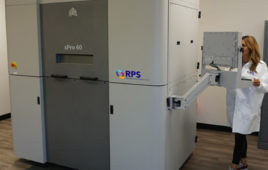Just across the East River from midtown Manhattan’s shimmering skyscrapers sits one of America’s most polluted neighborhoods, fouled by generations of industrial waste, overflow from the city’s sewage system and an underground oil leak bigger than the Exxon Valdez spill.
It’s easy to see — and smell — the filth in and around Newtown Creek, which runs through an area of working-class homes, warehouses and industrial lots straddling the boroughs of Brooklyn and Queens. The odor of petroleum mixes with the smell of sewage, particularly on rainy days when the city’s treatment plants can’t handle the volume and municipal pipes send trash and human waste straight into the creek.
Oily, rainbow-slicked water is filled with soda cans, plastic bottles, raw sewage and decaying food. Ditched vehicles are stuck in the mud on the banks. And what was once a creek teeming with fish, surrounded by marshland, is now a dull gray waterway that cannot sustain life.
“It’s the byproduct of our society,” says environmentalist John Lipscomb of the Riverkeeper clean-water advocacy group. “What was originally a watershed is now a sewage shed.”
After generations of neglect, the first, small steps are being taken in a multi-pronged cleanup that could take at least a dozen years and cost hundreds of millions of dollars. But even the most hopeful officials acknowledge the watershed may never be clear of all pollutants.
There was a time when Newtown Creek was the city’s industrial mecca. The Rockefellers operated the first modern American refineries on its banks in the late 1800s. Others quickly sprang up.
For much of the 20th century, the neighborhood teemed with commercial vessels and factories that made products as varied as fertilizers, chemicals, lumber and glue. Their oil and other hazardous waste was either dumped or leaked into the creek, bit by bit, accumulating at the bottom.
The first sign of the looming ecological disaster came on Oct. 5, 1950, when petroleum gases from the hidden spill seeped into the sewer and caught fire, causing an explosion that blew dozens of manhole covers three stories into the air, shattering windows in hundreds of buildings and ripping a street open. Three people were injured.
But decades would pass before the creek got any real attention.
The U.S. Environmental Protection Agency declared Newtown Creek a Superfund site in 2010 — “one of the most polluted urban water bodies in the country,” according to EPA regional administrator Judith Enck.
Today, the creek’s bottom is lined with a 15-foot (4.5-meter)-thick layer of petroleum-based pollutants that scientists have dubbed “black mayonnaise.” The ooze penetrated the shoreline and now sits on top of the water table dozens of feet under Brooklyn’s gentrifying Greenpoint neighborhood. More than 300,000 people still live within a mile of the creek.
Scientists are using sonar to probe the muck in the 3.5-mile (5.6-kilometer) waterway in hopes of determining the best way to conduct the cleanup, which will be financed by six entities that inherited the pollution: Exxon Mobil, Texaco Inc., the Phelps Dodge Refining Corp., BP Products North America Inc., National Grid NY and the city of New York.
One method used at other Superfund sites is to dredge the sediment from barges carrying cranes with scoopers, then capping the bottom to block any residue of oil, pesticides, chemicals and other pollutants.
“The mud is so heavily saturated with oil you can smell it,” says Phillip Musegaas, a Riverkeeper attorney who spearheaded several lawsuits linked to the pollution. “I’ve never seen anything like it.”
A separate cleanup targets the Greenpoint underground oil spill, which covers the equivalent of about 55 football fields. By some estimates, the oil spilled there amounted to as much as 30 million gallons (113 million liters), dwarfing the 11 million gallons (41 million liters) released by the Exxon Valdez tanker in Alaska in 1989.
Exactly how so much oil spread through the ground is still a question, but one thing is certain, according to the EPA: The sources of the spill were dozens of oil refineries and storage tanks built along the banks of Newtown Creek starting in the 1860s. Their petroleum and waste discharges leaked or were dumped into both the soil and the water at a time when there was little regulation or oversight. Some may have come from ships carrying the oil.
Under terms of a 2010 settlement with then-New York Attorney General Andrew Cuomo and a related agreement with Riverkeeper, Exxon Mobil agreed to pay $19.5 million for projects to benefit the area’s environment. The question of who will pay for the creek’s entire cleanup will be answered after preliminary EPA studies are done.
So far, 12 million gallons (45 million liters) of oil have been extracted using pumps inserted into dozens of wells.
When the two cleanups are done — on separate timetables — there’s still “the icing on the cupcake,” as Musegaas calls about 1½ billion gallons of wastewater that flows into Newtown Creek each year from the city’s combined sewage and storm drain pipes.
The city is working to reduce stormwater flow into the sewer system, with a plan to gradually divert it to porous street pavements, green rooftops and rain harvesting equipment. Now, the rainwater pouring into street drains ends up in antiquated pipes that receive both wastewater and sewage, overwhelming treatment plants. The overflow goes into city rivers and creeks like Newtown.
“It’s never going to be pristine, the way it was 500 years ago,” says Walter Mugdan, an EPA official overseeing the Superfund site. “But we can make it dramatically cleaner than it is now.”
On the creek, nature survives — just barely, with egrets perched along the bulkheads and grass pushing up from defunct docks.
The cries of seagulls fill the air as they swoop over a junkyard that sells scrap metal to China. There’s a lumber yard nearby, plus warehouses storing fruit and produce that feeds the city.
On the Queens side, an immigrant Vietnamese family just opened a small Asian restaurant called The Bunker, where they’ve installed air- and water-purifying devices “to create a healthy haven here, an oasis from the pollution in the neighborhood,” says chef Jimmy Tu.
Until the 1990s, the gritty neighborhood was filled with Polish, Russian and Italian immigrants and their families.
With Manhattan property prices skyrocketing, a luxury waterfront community called Greenpoint Landing will start rising this summer near the East River mouth of Newtown Creek, 10 residential towers with 5,000 apartments, a marina, a retail complex and a prime view of the city.
A short walk away is a hulking brick building where rope was once braided for ships. It’s been turned into space for entrepreneurs and artists who are among a new breed of locals.
Newtown Creek is the story of New York’s rich and poor — and the changing times, says Karl LaRocca, a 39-year-old printmaker.
When the oil refineries were booming, “the rich people were all living farther away and using this for their industry,” he says. “Now we’ve had this reversal where the waterfront is this desirable property, and that’s why they’re cleaning up.”
Filed Under: Rapid prototyping




